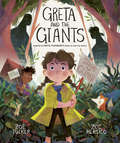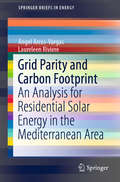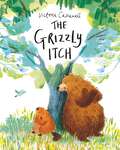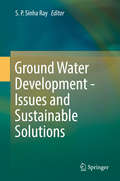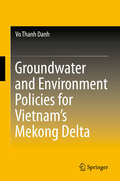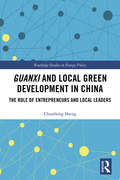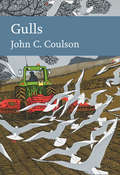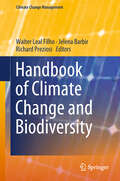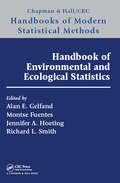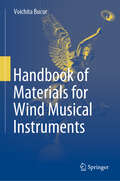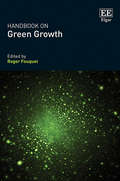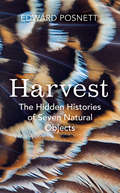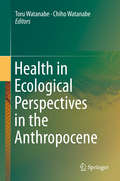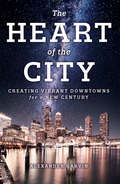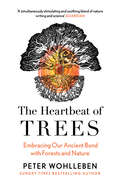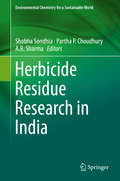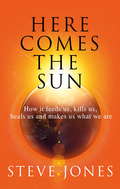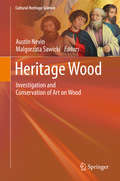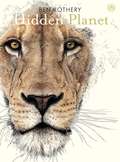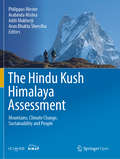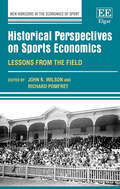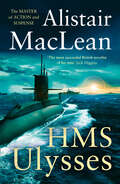- Table View
- List View
Greta and the Giants: inspired by Greta Thunberg's stand to save the world
by Zoë Tucker Zoe PersicoThis inspiring picture book retells the story of Nobel Peace Prize nominee Greta Thunberg – the Swedish teenager who has led a global movement to raise awareness about the world’s climate crisis – using allegory to make this important topic accessible to young children. Greta is a little girl who lives in a beautiful forest threatened by Giants. When the Giants first came to the forest, they chopped down trees to make houses. Then they chopped down more trees and made even bigger homes. The houses grew into towns and the towns grew into cities, until now there is hardly any forest left. Greta knows she has to help the animals who live in the forest, but how? Luckily, Greta has an idea… A section at the back explains that, in reality, the fight against the 'giants' isn’t over and explains how you can help Greta in her fight. This book has been printed sustainably in the UK on 100% recycled paper. By buying a copy of this book, you are making a donation of 3% of the cover price to Greenpeace UK.
Greyhound: Discover the gripping naval thriller behind the major motion picture starring Tom Hanks
by C.S. ForesterNOW A MAJOR FILM STARRING TOM HANKSDiscover the acclaimed wartime classic from C. S. Forester - originally published as The Good Shepherd'Unbelievably good' James Holland, bestselling author of Normandy '44 It's 1942. America has just joined the war.Greyhound, an international convoy of thirty-seven allied ships, is in operation.Captain Krause must lead his first command of a US destroyer as the convoy ploughs through the icy, submarine-infested North Atlantic seas.For forty-eight hours, Krause will play a desperate cat and mouse game against the wolf packs of German U-boats. His mission looks doomed to fail. But armed with extraordinary courage and grit, hope may just be on the horizon. . .This is a riveting classic of naval warfare from the author of the legendary Hornblower series.'High and glittering excitement' New York Times
Grid Parity and Carbon Footprint: An Analysis for Residential Solar Energy in the Mediterranean Area (SpringerBriefs in Energy)
by Ángel Arcos-Vargas Laureleen RiviereThis book analyses the economic and environmental aspects of installing photovoltaic facilities for residential electricity users and determines whether the installation of photovoltaic units “behind the meter” makes sense, and if so, the best economic size to install. It explores the use of photovoltaic capacity to meet electricity requirements by generating enough for immediate use without feeding surplus electricity into the grid and without using storage. The authors illustrate this approach by examining various power photovoltaic capacities in locations such as Marseille, Madrid and Seville, which use hourly demand data provided by smart meters. They also show the possibility of developing energy self-consumption compatible with the operation of the network, making use of information from smart meters. Discussing how photovoltaic facilities are profitable from both an economic and an environmental point of view, this book is a valuable resource for researchers and private investors. It is also of interest to practitioners and academics, as the results presented are of importance for the near future.
The Grizzly Itch
by Victoria CassanellA funny and lighthearted story about friendship, sharing, and a deep love of nature and the joy it can bring.The first picture book from outstanding talent, Victoria Cassanell, The Grizzly Itch is a hilarious tale about how helping people often yields unexpected and wonderful surprises. Perfect for teaching children how to navigate first friendships and to encourage them to respect and enjoy the natural world.When Bear wakes up from his winter sleep, he discovers an itch. And not just any itch – an unBEARable Grizzly Itch. But when he gets to his favourite scratching tree, it suddenly crashes to the ground. It turns out Beaver likes trees too . . . Thankfully, Beaver knows lots of other trees, and promises to help Bear find a new one. But Bear's itch is getting more grizzly by the minute, and none of the trees Beaver show him are quite right. Maybe it's not a tree Bear needs, after all?
Ground Water Development - Issues and Sustainable Solutions
by S. P. RayGround water resources are receiving global attention, as human population growth and development cause significant changes to the earth system. It plays a major role in ensuring livelihood security in many parts of South Asia and its contribution to poverty alleviation is substantial. The complex nature of ground water problems in the Indian Sub-continent requires a precise delineation of the ground water regimes in different hydro geological settings and socio-economic conditions and is a primary necessity for sustainable and equitable management. Strategies to respond to ground water over-exploitation and deteriorating water quality must be based on a new approach. Practical policies and various solution options urgently need to be formulated and implemented to prevent the development problems. There is pressing need to evolve workable methods and approaches based on modern scientific researches on ground water resources, as well as to build a social framework including community participation at all levels for a ground water development system. The community participation in water pumping policies, incentives of efficient use, affordability of low income users and other vulnerable groups, water awareness are prime factors for success of any ground water based water supply project.
Groundwater and Environment Policies for Vietnam’s Mekong Delta
by Vo Thanh DanhThis book provides an in-depth analysis of groundwater uses and environmental issues in the Mekong Delta. It focuses on groundwater pollution and use, urban flooding, living with flood policy, and climate change-related adaptation measures. The Mekong Delta is facing these serious issues in the course of its development.This book uses economic analysis methods such as risk cost benefit analysis, cost effectiveness analysis, contingent valuation method, economic loss valuation, and multi criteria analysis to provide policy makers and researchers a better understanding of issues faced by sea level rise-impacted regions around the world and provide possible solutions. Students of environmental economics, economic valuation, and public policy can use this work to enhance their analytical skills.
Guanxi and Local Green Development in China: The Role of Entrepreneurs and Local Leaders (Routledge Studies in Environmental Policy)
by Chunhong ShengThis book examines the factors which contribute to local green development in China and employs political ecology to analyze the relationship between power and the environment. Specifically, it looks at which actors control access to resources and are therefore able to promote environmental progress. Following the reform and opening-up of China in the 1970s, entrepreneurs and local officials profited economically and politically and formed close relationships, known as guanxi in China. As a result, they have also been criticized as those responsible for the associated ecological damage. This book does not contest this association, but instead argues that the current literature places too much emphasis on their negative influence and the positive influence of their environmental work has been neglected. Building on three case studies where local green development is being pursued, Shanghai Pudong New Area, Baoding, and Wuning, this book shows how local officials and entrepreneurs can also be the crusaders of a greener environment at the local level in China. This book will be of great interest to students and scholars of Chinese studies, with a particular interest in environmental policy and politics, business and society, as well as those interested in sustainable development more broadly.
Guanxi and Local Green Development in China: The Role of Entrepreneurs and Local Leaders (Routledge Studies in Environmental Policy)
by Chunhong ShengThis book examines the factors which contribute to local green development in China and employs political ecology to analyze the relationship between power and the environment. Specifically, it looks at which actors control access to resources and are therefore able to promote environmental progress. Following the reform and opening-up of China in the 1970s, entrepreneurs and local officials profited economically and politically and formed close relationships, known as guanxi in China. As a result, they have also been criticized as those responsible for the associated ecological damage. This book does not contest this association, but instead argues that the current literature places too much emphasis on their negative influence and the positive influence of their environmental work has been neglected. Building on three case studies where local green development is being pursued, Shanghai Pudong New Area, Baoding, and Wuning, this book shows how local officials and entrepreneurs can also be the crusaders of a greener environment at the local level in China. This book will be of great interest to students and scholars of Chinese studies, with a particular interest in environmental policy and politics, business and society, as well as those interested in sustainable development more broadly.
Gulls (Collins New Naturalist Library #139)
by Professor John CoulsonThe gull is a familiar sight by the seaside, and one of the most recognisable bird species, but most people know surprisingly little about the lives and habits of these seafaring birds. John C. Coulson remedies this with a comprehensive overview of the gull.
Handbook of Climate Change and Biodiversity (Climate Change Management)
by Walter Leal Filho Jelena Barbir Richard PreziosiThis book comprehensively describes essential research and projects on climate change and biodiversity. Moreover, it includes contributions on how to promote the climate agenda and biodiversity conservation at the local level. Climate change as a whole and global warming in particular are known to have a negative impact on biodiversity in three main ways. Firstly, increases in temperatures are detrimental to a number of organisms, especially those in sensitive habitats such as coral reefs and rainforests. Secondly, the pressures posed by a changing climate may lead to sets of responses in areas as varied as phenology, range and physiology of living organisms, often leading to changes in their lifecycles (especially but not only in reproduction), losses in productivity or even death. In some cases, the very survival of very sensitive species may be endangered. Thirdly, the impacts of climate change on biodiversity will be felt in the short term with regard to some species and ecosystems, but also in the medium and long term in many biomes. Indeed, if left unchecked, some of these impacts may be irreversible. Many individual governments, financial institutes and international donors are currently spending billions of dollars on projects addressing climate change and biodiversity, but with little coordination. Quite often, the emphasis is on adaptation efforts, with little emphasis on the connections between physio-ecological changes and the lifecycles and metabolisms of fauna and flora, or the influence of poor governance on biodiversity. As such, there is a recognized need to not only better understand the impacts of climate change on biodiversity, but to also identify, test and implement measures aimed at managing the many risks that climate change poses to fauna, flora and micro-organisms. In particular, the question of how to restore and protect ecosystems from the impact of climate change also has to be urgently addressed. This book was written to address this need. The respective papers explore matters related to the use of an ecosystem-based approach to increase local adaptation capacity, consider the significance of a protected areas network in preserving biodiversity in a changing northern European climate, and assess the impacts of climate change on specific species, including wild terrestrial animals. The book also presents a variety of case studies such as the Yellowstone to Yukon Conservation Initiative, the effects of climate change on the biodiversity of Aleppo pine forest in Senalba (Algeria), climate change and biodiversity response in the Niger Delta region, and the effects of forest fires on the biodiversity and the soil characteristics of tropical peatlands in Indonesia. This is a truly interdisciplinary publication, and will benefit all scholars, social movements, practitioners and members of governmental agencies engaged in research and/or executing projects on climate change and biodiversity around the world.
Handbook of Environmental and Ecological Statistics (ISSN)
by Alan E. Gelfand Montserrat Fuentes Jennifer A. Hoeting Richard Lyttleton SmithThis handbook focuses on the enormous literature applying statistical methodology and modelling to environmental and ecological processes. The 21st century statistics community has become increasingly interdisciplinary, bringing a large collection of modern tools to all areas of application in environmental processes. In addition, the environmental community has substantially increased its scope of data collection including observational data, satellite-derived data, and computer model output. The resultant impact in this latter community has been substantial; no longer are simple regression and analysis of variance methods adequate. The contribution of this handbook is to assemble a state-of-the-art view of this interface. Features: An internationally regarded editorial team. A distinguished collection of contributors. A thoroughly contemporary treatment of a substantial interdisciplinary interface. Written to engage both statisticians as well as quantitative environmental researchers. 34 chapters covering methodology, ecological processes, environmental exposure, and statistical methods in climate science.
Handbook of Environmental and Ecological Statistics (ISSN)
by Alan Gelfand; Montse Fuentes; Jennifer A. Hoeting; Richard L. SmithThis handbook focuses on the enormous literature applying statistical methodology and modelling to environmental and ecological processes. The 21st century statistics community has become increasingly interdisciplinary, bringing a large collection of modern tools to all areas of application in environmental processes. In addition, the environmental community has substantially increased its scope of data collection including observational data, satellite-derived data, and computer model output. The resultant impact in this latter community has been substantial; no longer are simple regression and analysis of variance methods adequate. The contribution of this handbook is to assemble a state-of-the-art view of this interface. Features: An internationally regarded editorial team. A distinguished collection of contributors. A thoroughly contemporary treatment of a substantial interdisciplinary interface. Written to engage both statisticians as well as quantitative environmental researchers. 34 chapters covering methodology, ecological processes, environmental exposure, and statistical methods in climate science.
Handbook of Materials for Wind Musical Instruments
by Voichita BucurThis book addresses key questions about the materials used for the wind instruments of classical symphony orchestra such as flutes, clarinets, saxophones, oboes, bassoons and pipe organs. The content of this book is structured into four parts.Part 1- Description of materials for wind instruments deals with wood species and materials for reeds used for making clarinet, oboe and bassoon- and, with metallic materials and alloys for - horn, trumpet, trombone, etc. Auxiliary materials associated with the manufacturing of wind instruments are felt, cork, leather and parchment. Part 2- Basic acoustics of wind instruments, in which are presented succinctly, some pertinent aspects related to the physics of the resonant air column. An important aspect discussed is related to the effect of wall material on the vibration modes of the walls of wind instruments. The methods for measuring the acoustical properties of wind instruments are presented. Part 3- Manufacturing of wind instruments, describes the technology used in manufacturing metallic tubes and pipes made of wood. Part 4 - The durability and degradation of materials addresses data about methods for cleaning wind instruments, studies factors producing degradation of organ pipes, describes methods of conservation and restoration of brass instruments and of historical pipe organs. Finally, the properties of marble are described, being the only one nondegradable and sustainable material used for pipes for organs.
Handbook on Green Growth
by Roger FouquetEconomies around the world have arrived at a critical juncture: to continue to grow fuelled by fossil fuels and exacerbate climate change, or to move towards more sustainable, greener, growth. Choosing the latter is shown to help address climate change, as well as present new economic opportunities. This Handbook provides a deeper understanding of the concept of green growth, and highlights key lessons from the experience of green transformations across the world following a decade of ambitious stimulus packages and green reforms. With comprehensive chapters from key researchers in the field drawn from across the globe, the Handbook on Green Growth offers up to date and original analysis of the many facets of the phenomenon of green growth. Is economic growth desirable? When can economic growth and environmental policies work together? What are the key factors that will achieve green growth? What will be the multiple impacts of green growth? And, what have been the experiences of economies that have undertaken a green transformation? This Handbook will be a key resource for students and academics interested in economics, environmental and ecological studies, as well as for those specialising in environmental policy. It will also be a valuable tool for policy makers concerned about the dual objectives of stimulating economic growth and addressing environmental damage.
Harvest: The Hidden Histories of Seven Natural Objects
by Edward Posnett‘An exceptional first book; Harvest is a subtle, fascinating braiding of travel, cultural and natural history … It is a pleasure and an education to journey with him in these pages’ Robert MacfarlaneIn a centuries-old tradition, farmers in northwestern Iceland scour remote coastal plains for the down of nesting eider ducks.High inside a vast cave in Borneo, men perched atop rickety ladders collect swiftlets’ nests, a delicacy believed to be a cure for almost anything.Eiderdown and edible birds’ nests: both are luxury products, ultimately destined for the super-rich. To the rest of the world these materials are mere commodities but to the harvesters they are all imbued with myth, tradition, folklore and ritual, and form part of a shared identity and history.These objects are two of the seven natural wonders whose stories Harvest tells: eiderdown, vicuña wool, sea silk, vegetable ivory, civet coffee, guano and edible birds’ nests. Harvest follows their journey from the wildest parts of the planet, traversing Iceland, Indonesia, and Peru, to its urban centres, drawing on the voices of the gatherers, shearers and entrepreneurs who harvest, process and trade them.Blending interviews, history and travel writing, Harvest sets these human stories against our changing economic and ecological landscape. What do they tell us about capitalism, global market forces and overharvesting? How does a local micro-economy survive in a hyper-connected world?Harvest makes us see the world with wonder, curiosity and new concern. It is an original and magical new map of our world and its riches.
Health in Ecological Perspectives in the Anthropocene
by Toru Watanabe Chiho WatanabeThis book focuses on the emerging health issues due to climate change, particularly emphasizing the situation in developing countries. Thanks to recent development in the areas of remote sensing, GIS technology, and downscale modeling of climate, it has now become possible to depict and predict the relationship between environmental factors and health-related event data with a meaningful spatial and temporal scale. The chapters address new aspects of environment-health relationship relevant to this smaller scale analyses, including how considering people’s mobility changes the exposure profile to certain environmental factors, how considering behavioral characteristics is important in predicting diarrhea risks after urban flood, and how small-scale land use patterns will affect the risk of infection by certain parasites, and subtle topography of the land profile. Through the combination of reviews and case studies, the reader would be able to learn how the issues of health and climate/social changes can be addressed using available technology and datasets. The post-2015 UN agenda has just put forward, and tremendous efforts have been started to develop and establish appropriate indicators to achieve the SDG goals. This book will also serve as a useful guide for creating such an indicator associated with health and planning, in line with the Ecohealth concept, the major tone of this book. With the increasing and pressing needs for adaptation to climate change, as well as societal change, this would be a very timely publication in this trans-disciplinary field.
The Heart of the City: Creating Vibrant Downtowns for a New Century
by Alexander GarvinDowntowns are more than economic engines: they are repositories of knowledge and culture and generators of new ideas, technology, and ventures. They are the heart of the city that drives its future. If we are to have healthy downtowns, we need to understand what downtown is all about; how and why some American downtowns never stopped thriving (such as San Jose and Houston), some have been in decline for half a century (including Detroit and St. Louis), and still others are resurging after temporary decline (many, including Lower Manhattan and Los Angeles). The downtowns that are prospering are those that more easily adapt to changing needs and lifestyles.In The Heart of the City, distinguished urban planner Alexander Garvin shares lessons on how to plan for a mix of housing, businesses, and attractions; enhance the public realm; improve mobility; and successfully manage downtown services. Garvin opens the book with diagnoses of downtowns across the United States, including the people, businesses, institutions, and public agencies implementing changes. In a review of prescriptions and treatments for any downtown, Garvin shares brief accounts—of both successes and failures—of what individuals with very different objectives have done to change their downtowns. The final chapters look at what is possible for downtowns in the future, closing with suggested national, state, and local legislation to create standard downtown business improvement districts to better manage downtowns.This book will help public officials, civic organizations, downtown business property owners, and people who care about cities learn from successful recent actions in downtowns across the country, and expand opportunities facing their downtown. Garvin provides recommendations for continuing actions to help any downtown thrive, ensuring a prosperous and thrilling future for the 21st-century American city.
The Heartbeat of Trees
by Peter WohllebenFROM THE AUTHOR OF THE SUNDAY TIMES BESTSELLER, THE HIDDEN LIFE OF TREES ‘A simultaneously stimulating and soothing blend of nature writing and science … Strongly encourages tree hugging for our own, human sake’ Guardian Summer Reads 2021
Herbicide Residue Research in India (Environmental Chemistry for a Sustainable World #12)
by Shobha Sondhia Partha P. Choudhury A. R. SharmaHerbicides constitute about 60% of the total pesticides consumed globally. In India, the use of herbicides started initially in tea gardens and picked up in the 1970s, when the high-yielding varieties of rice and wheat were introduced. Presently, 67 herbicides are registered in the country for controlling weeds in crops including cereals, pulses, oilseeds, fibre and tuber crops, and also in the non-crop situations. These chemicals are becoming increasingly popular because of their efficiency and relatively low cost compared with manual or mechanical weeding operations. The contribution of herbicide to total pesticide use, which was only 10-15% during the first decade of the 21st century, has now increased to about 25% with an annual growth rate of 15-20%, which is much higher than insecticides and fungicides. Though the application of herbicides is minimizing yield loss to a great extent, their residues in the food chain and surface and groundwater create some environmental nuisance particularly to non-target organisms. Research on pesticide residues in India was started during 1970s, when such chemicals were introduced on a greater scale along with high-yielding variety seeds, irrigation and chemical fertilizers for increasing food production. However, the herbicide residue research was not given much emphasis until 1990s. The Indian Council of Agricultural Research initiated a national level programme known as All India Coordinated Research Project on Weed Management through the NRC-Weed Science as the main centre along with some centers of ICAR Institutes and state agricultural universities. Over the last two decades, adequate information was generated on estimation, degradation and mitigation of herbicide residues, which were documented in annual reports, bulletins, monographs and scientific articles. However, there was no consolidated compilation of all the available information providing a critical analysis of herbicide residues. Accordingly, an effort has been made in the publication to compile the available information on herbicide residues in India. This is the first report of its kind which presents the findings of herbicide residues and their interactions in the biotic and abiotic environment. There are 16 chapters contributed by the leading herbicide residue scientists, each describing the present status of herbicide use, crops and cropping systems, monitoring, degradation and mitigation, followed by conclusions and future lines of work.This book will be useful to the weed scientists in general and herbicide residue chemists in particular, besides the policy makers, students and all those concerned with the agricultural production in the country.
Here Comes the Sun: How it feeds us, kills us, heals us and makes us what we are
by Professor Steve JonesOur sun drives the weather, forms the landscape, feeds and fuels - but sometimes destroys - the creatures that live upon it, controls their patterns of activity, makes chemicals in the skin that cheer up those who bask in its rays, and for the ancients was the seat of divine authority.In Here Comes the Sun, Steve Jones shows how life on Earth is ruled by our nearest star. It is filled with unexpected connections; between the need to stay cool and man's ability to stand upright, between the power of memory and the onset of darkness, between the flow of solar energy through the plants and animals and of wealth through society, and between Joseph Goebbel's 1938 scheme to make Edinburgh the summer capital of a defeated Britain and the widening gap in the life expectancy of Scottish men compared to that of other European men brought on by thnat nation's cloudy climate. Its author charts some of his own research in places hot and cold across the globe on the genetic and evolutionary effects of sunlight on snails, fruit-flies and people and shows how what was once no more an eccentric specialism has grown to become a subject of wide scientific, social and political significance. Stunningly evocative, beautifully written and packed full of insight, Here Comes the Sun is Steve Jones's most personal book to date.
Heritage Wood: Investigation and Conservation of Art on Wood (Cultural Heritage Science)
by Austin Nevin Malgorzata SawickiThis volume highlights recent research efforts in the conservation and investigation of works of art on wood. Through eleven case studies it showcases different experimental methods ranging from X-ray analysis of objects to the study of cross-sections made from micro-samples. New research focusing on the technical study, treatment and assessment of works of art on wood in its many forms is featured in this edited volume. Technical studies include the attribution and investigations of a triptych by Hans Memling and a sculpture from workshop of Michel and Gregor Erhart, decorated Syrian rooms, and investigations of finely carved Gothic wooden objects. Synchrotron-based methods are presented for studying the alteration of 19th c. verdigris in Norway, and multi-analytical methods are employed for the investigations of 16th to 19th c. East Asian lacquer from the Kunsthistorisches Museum in Vienna. Novel methods for the cleaning of gilded surfaces using gels and emulsions are shown, as are innovative strategies for the consolidation for waterlogged wood, providing key data for the assessment of risks and benefits of new methods, and the short and long-term effects on gilding layers and archaeological wood. The book clearly shows how collaboration between engineers, physicists, biologists and chemists and conservators of different types of materials can lead to new research in conservation science. This book is crucial reading for conservators and conservation scientists, as well as for technical art historians, providing key methodological case studies of polychromy from different temporal and geographical contexts.
Hidden Planet: An Illustrator's Love Letter to Planet Earth
by Ben RotheryPerfect for animal-lovers everywhere! A beautiful, large-format crossover book for all ages, this is the book natural-history illustrator Ben has wanted to read since he was a child. Facts and descriptions provide insight into a curated collection of birds and animals - some endangered and some less so - told from the perspective of a detail-obsessed illustrator. Fun to read together or independently, let the secrets of the animals on our planet come to life in vibrant detail.'This is my love letter to Planet Earth; a celebration of her hidden species, from the bold and the beautiful to the interesting but ugly. And while not a complete list, I hope that these few give a glimpse of the outstanding diversity of nature' - Ben Rothery Sensational Butterflies is also available.
The Hindu Kush Himalaya Assessment: Mountains, Climate Change, Sustainability and People
by Philippus Wester Arabinda Mishra Aditi Mukherji Arun Bhakta ShresthaThis open access volume is the first comprehensive assessment of the Hindu Kush Himalaya (HKH) region. It comprises important scientific research on the social, economic, and environmental pillars of sustainable mountain development and will serve as a basis for evidence-based decision-making to safeguard the environment and advance people’s well-being. The compiled content is based on the collective knowledge of over 300 leading researchers, experts and policymakers, brought together by the Hindu Kush Himalayan Monitoring and Assessment Programme (HIMAP) under the coordination of the International Centre for Integrated Mountain Development (ICIMOD). This assessment was conducted between 2013 and 2017 as the first of a series of monitoring and assessment reports, under the guidance of the HIMAP Steering Committee: Eklabya Sharma (ICIMOD), Atiq Raman (Bangladesh), Yuba Raj Khatiwada (Nepal), Linxiu Zhang (China), Surendra Pratap Singh (India), Tandong Yao (China) and David Molden (ICIMOD and Chair of the HIMAP SC).This First HKH Assessment Report consists of 16 chapters, which comprehensively assess the current state of knowledge of the HKH region, increase the understanding of various drivers of change and their impacts, address critical data gaps and develop a set of evidence-based and actionable policy solutions and recommendations. These are linked to nine mountain priorities for the mountains and people of the HKH consistent with the Sustainable Development Goals. This book is a must-read for policy makers, academics and students interested in this important region and an essentially important resource for contributors to global assessments such as the IPCC reports.
Historical Perspectives on Sports Economics: Lessons from the Field (New Horizons in the Economics of Sport series)
by John K. Wilson Richard PomfretThe sports sector, apart from being of economic significance in itself, is clearly one that many citizens share a great interest in. It is not mere results, but aspects such as history, statistics, interest in labour markets and finances that often spark people’s interest. The characteristics of the sports sector and the data it provides allows economists to cast light on a large number of economic issues facing society. Historical Perspectives on Sports Economics explores a variety of topics, including mega-event analysis, sports governance, anthropometrics, gambling, industrial organisation, infrastructure development and racial issues. The analysis is sufficiently non-technical and will appeal not only to academic economists and students, but to historians and sports enthusiasts as well.
HMS Ulysses
by Alistair MacLeanThe novel that launched the astonishing career of one of the 20th century’s greatest writers of action and suspense – an acclaimed classic of heroism and the sea in World War II. Now reissued in a new cover style.
